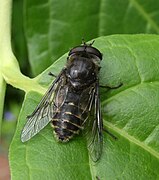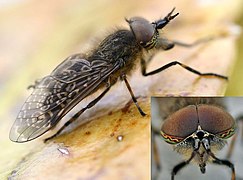Tabanidae
The tabanids (Tabanidae) are a family of brachycerous diptera insects commonly known as horses that, like the rest of the diptera, only they have two functional wings, the anterior ones. The hind wings have been transformed into halteres or rockers, appendages that help control the flight, which allows them to fly very actively and efficiently, reaching 30 kilometers per hour in straight flight, particularly the meadow horseflies (genus Tabanus, Hybomitra, Chlorotabanus, etc.), rather than those from forest habitats, such as Chrysops. They are found throughout the world except for some islands and the polar regions (Hawaii, Greenland and Iceland).
This family has 4,500 species around the world, of which 1,000 belong to the genus Tabanus. According to the 1994 catalog of Tabanidae Neotropical, 1,172 species and subspecies have been described in the Neotropical Region and only 4.1% of the larvae are known. However, more recent studies from 2009 estimate a number of 1,082 species.
Adult horseflies feed on nectar and exudate from plants; males have weak insect mouthparts and only females bite animals to obtain enough protein from the blood to produce eggs. The females' mouthparts are formed into a strong stinging organ with two pairs of sharp blades and a sponge-like part used to lick up blood flowing from the wound. The larvae are predatory and grow in semi-aquatic habitats.
The family Tabanidae is divided into three subfamilies:
- Chrysopsinae Blanchard, 1840
- Pangoniinae Rondani, 1856
- Tabaninae Rondani, 1856
- Gender Zophina It's uncertain, but it's been classified in Pangoniinae.
Features
There is marked sexual dimorphism in tabanids that affects two aspects of their anatomy. First, females have a mouthpart capable of biting mammals to extract blood while males only extract plant juices, similar to mosquitoes.
Secondly, males are holoptic (their two eyes meet at one point) and females are dichoptic (their eyes remain separate); this is a trait shared with other families of flies, such as hoverflies, Pipunculidae, and Acroceridae.
Natural history
Most horseflies are diurnal, females more so than males. The latter are crepuscular and swarm or form groups waiting for the females to mate with them. Most horseflies have hematophagous females, that is, they feed on the blood they extract from endothermic vertebrates (wrongly called "warm-blooded", mammals and birds). The males, on the contrary, feed on the nectar and pollen of the flowers and their life is short, frequently dying after copulation, which makes it difficult to observe them. The females, as in the case of mosquitoes, need a food rich in protein, such as blood; these nutrients are necessary for egg production. In their search for food they orient themselves by lumps and colors; For this reason, female horseflies are more attracted to people who wear dark clothes and animals whose skin is equally dark (especially if they sweat actively) than to light-colored ones. In some places, their blood-sucking behavior makes them biological and mechanical vectors of some pathogens. Some African species of the genus Chrysops transmit a filarial nematode, Loa loa, which causes the so-called cutaneous filariasis or loasis in several million people.
Flies attack exposed areas of their victim, regardless of whether the victim discovers them or not. The bite is painful and leaves the affected area red, occasionally causing inflammation, redness and itching, which may require treatment with antibiotics. Its mouthparts are strong and long enough to pierce the skin of goats, donkeys, or horses.
Flies thrive and are abundant in moist habitats, regularly or seasonally inundated with fresh or brackish water, because they need soggy soils for their development (as eggs, larvae, and pupae) and as adults they need preferably large animals. When they appear as a plague next to racetracks or golf courses, their control is very difficult, and requires the application of chemical repellents on animals or people.
According to Greek mythology, the horsefly was created by Zeus to cause the death of the hero Bellerophon when on his last journey, to prove his worth, he traveled on Pegasus towards Mount Olympus, which was prohibited for mortals at that time. But it is dated even further back and its relevance and appearance in the Bible is described as one of the plagues in Egypt, described in the book of Exodus in chapter 8.
Contenido relacionado
Scallop
Atresia
Chaetostichium






